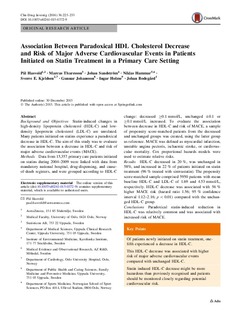| dc.contributor.author | Hasvold, Lars Pål | |
| dc.contributor.author | Thuresson, Marcus | |
| dc.contributor.author | Sundström, Johan | |
| dc.contributor.author | Hammar, Niklas | |
| dc.contributor.author | Kjeldsen, Sverre Erik | |
| dc.contributor.author | Johansson, Gunnar | |
| dc.contributor.author | Holme, Ingar Morten K. | |
| dc.contributor.author | Bodegard, Johan | |
| dc.date.accessioned | 2016-05-25T10:06:16Z | |
| dc.date.available | 2016-05-25T10:06:16Z | |
| dc.date.issued | 2016-03 | |
| dc.identifier.citation | Clinical Drug Investigation. 2016, 36, 225-233 | nb_NO |
| dc.identifier.uri | http://hdl.handle.net/11250/2390334 | |
| dc.description | © The Author(s) 2015
Open Access
This article is distributed under the terms of the Creative Commons Attribution-NonCommercial 4.0 International License (http://creativecommons.org/licenses/by-nc/4.0/), which permits any noncommercial use, distribution, and reproduction in any medium, provided you give appropriate credit to the original author(s) and the source, provide a link to the Creative Commons license, and indicate if changes were made. | nb_NO |
| dc.description.abstract | ABSTRACT
Background and Objectives:
Statin-induced changes in high-density lipoprotein cholesterol (HDL-C) and low-density lipoprotein cholesterol (LDL-C) are unrelated. Many patients initiated on statins experience a paradoxical decrease in HDL-C. The aim of this study was to evaluate the association between a decrease in HDL-C and risk of major adverse cardiovascular events (MACE).
Methods:
Data from 15,357 primary care patients initiated on statins during 2004–2009 were linked with data from mandatory national hospital, drug-dispensing, and cause-of-death registers, and were grouped according to HDL-C change: decreased ≥0.1 mmol/L, unchanged ±0.1 or ≥0.1 mmol/L increased. To evaluate the association between decrease in HDL-C and risk of MACE, a sample of propensity score-matched patients from the decreased and unchanged groups was created, using the latter group as reference. MACE was defined as myocardial infarction, unstable angina pectoris, ischaemic stroke, or cardiovascular mortality. Cox proportional hazards models were used to estimate relative risks.
Results:
HDL-C decreased in 20 %, was unchanged in 58%, and increased in 22 % of patients initiated on statin treatment (96 % treated with simvastatin). The propensity score-matched sample comprised 5950 patients with mean baseline HDL-C and LDL-C of 1.69 and 4.53 mmol/L, respectively. HDL-C decrease was associated with 56 % higher MACE risk (hazard ratio 1.56; 95 % confidence interval 1.12–2.16; p < 0.01) compared with the unchanged HDL-C group.
Conclusions:
Paradoxical statin-induced reduction in HDL-C was relatively common and was associated with increased risk of MACE. | nb_NO |
| dc.language.iso | eng | nb_NO |
| dc.publisher | Springer International Publishing | nb_NO |
| dc.title | Association between paradoxical HDL cholesterol decrease and risk of major adverse cardiovascular events in patients initiated on statin treatment in a primary care setting. | nb_NO |
| dc.type | Journal article | nb_NO |
| dc.type | Peer reviewed | nb_NO |
| dc.subject.nsi | VDP::Medical disciplines: 700 | nb_NO |
| dc.subject.nsi | VDP::Medical disciplines: 700::Basic medical, dental and veterinary science disciplines: 710 | nb_NO |
| dc.subject.nsi | VDP::Medical disciplines: 700::Basic medical, dental and veterinary science disciplines: 710::Pharmacology: 728 | nb_NO |
| dc.subject.nsi | VDP::Medical disciplines: 700::Basic medical, dental and veterinary science disciplines: 710::Toxicology: 730 | nb_NO |
| dc.source.journal | Clinical Drug Investigation | nb_NO |
| dc.description.localcode | Seksjon for idrettsmedisinske fag / Department of Sports Medicine | nb_NO |
